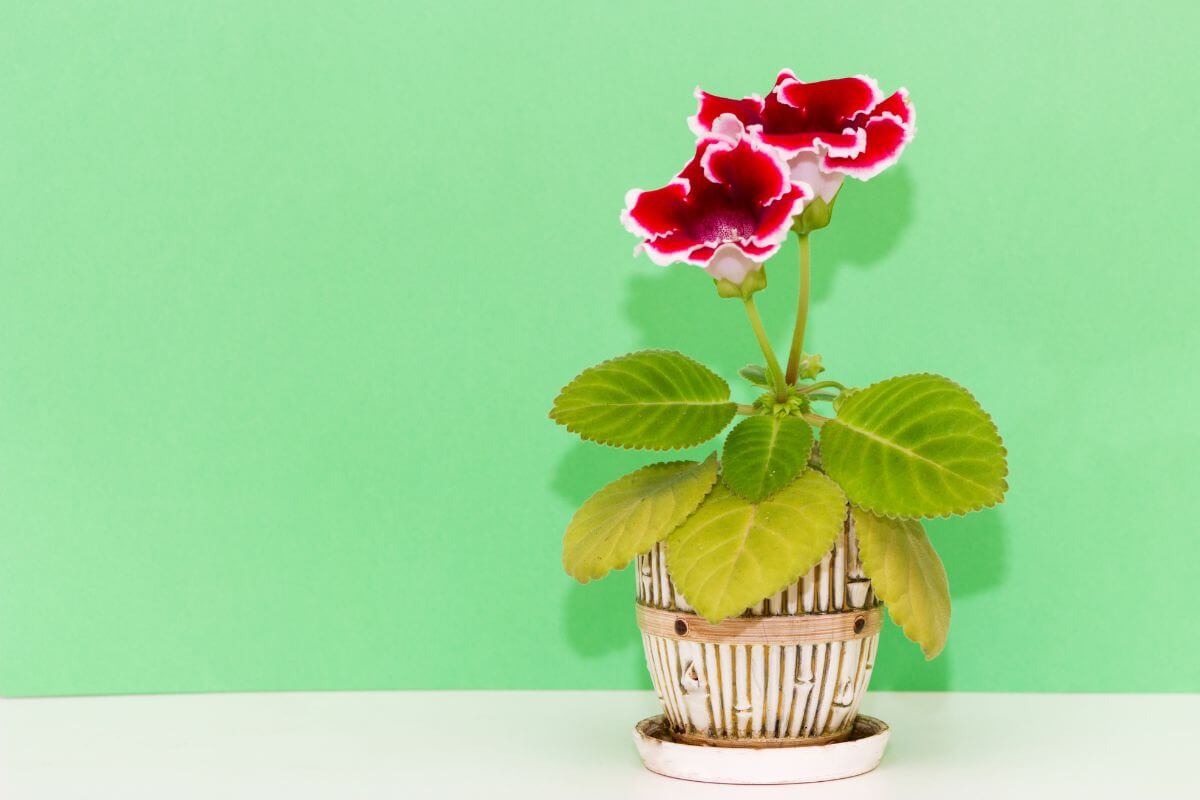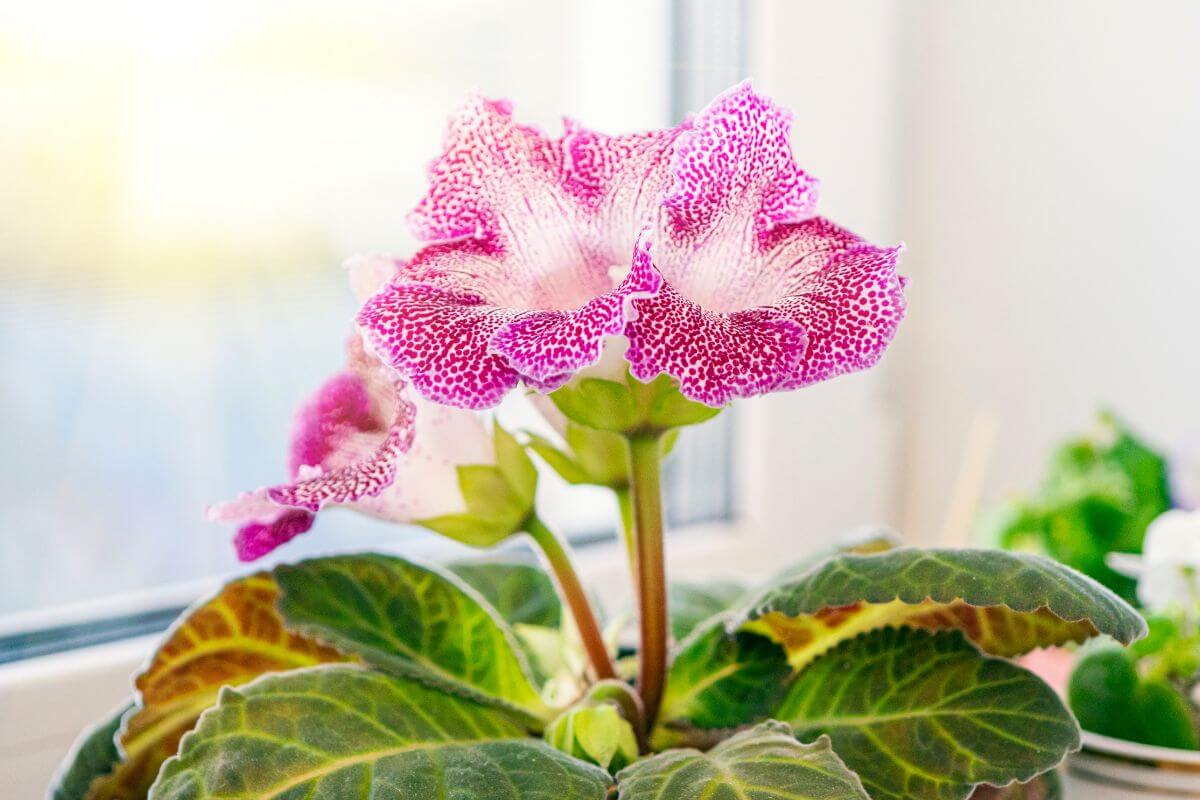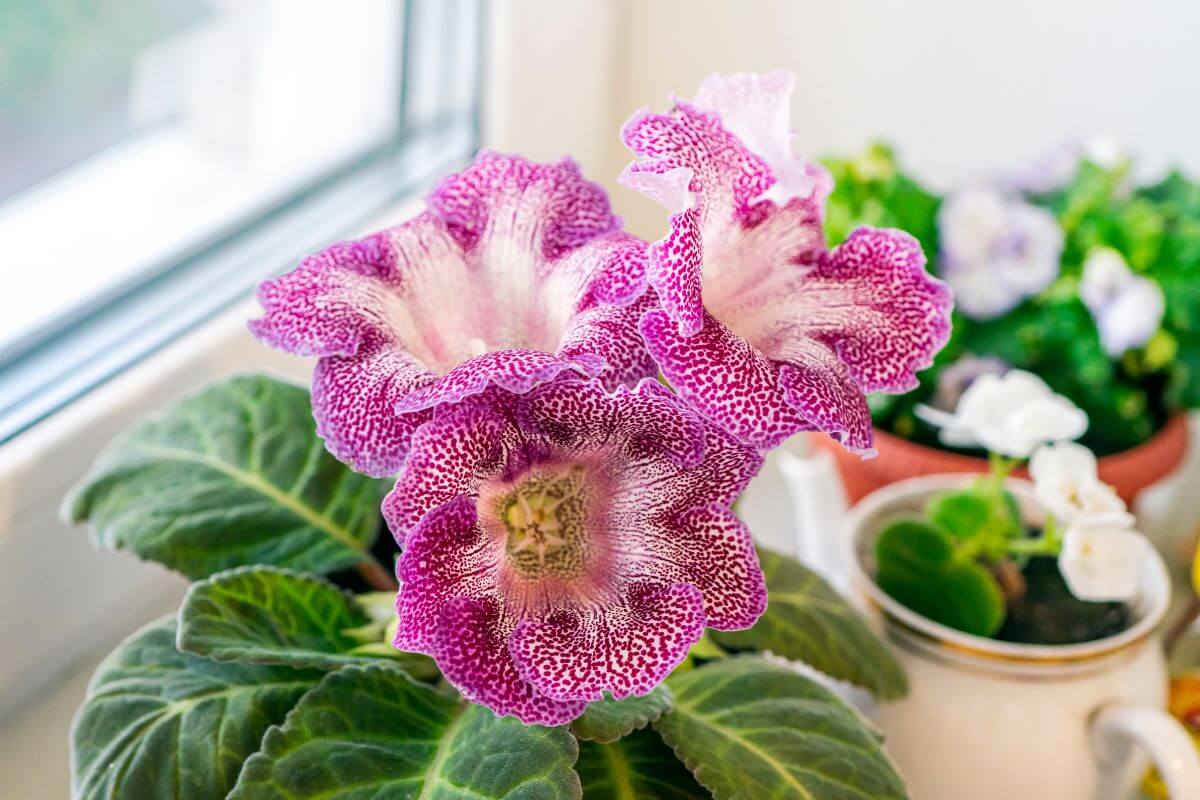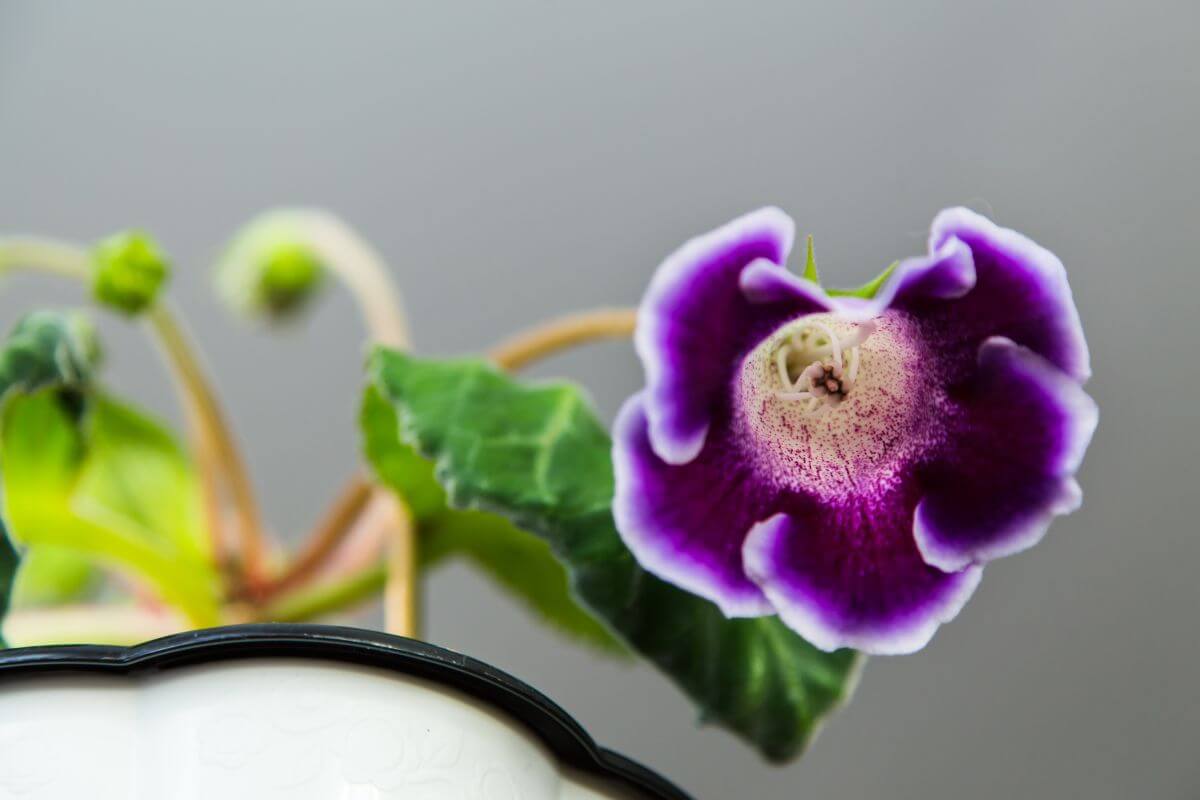Most houseplants are known and appreciated for their lush green foliage. While some will bloom even when cultivated indoors, but none may be as stunning as the Gloxinia Plant.
This is a hybrid houseplant loved for its large brightly colored flowers that will dress up any space. It is also known as “Florist’s Gloxinia”.
This guide will show you how to care for the gloxinia plant and grow ti successfully.
Gloxinia Plant Overview

The gloxinia plant is known for its blooms that are shaped like bells and grow toward the sky with an upright posture. Botanically named the Sinningia speciosa, the houseplant that we love and appreciate today is native to Brazil. It was brought over to England as early as 1815.
These showpiece plants are members of the Gesneriaceae family, as is the African Violet. However, unlike the African Violet, they will not flower the entire year.
Gloxinias will alternate between dormancy and growth, resembling the habits of another flowering plant, the Cyclamen Plant.
The gloxinia offers an large selection of hybrid varieties in lots of colors, including burgundy, gold, pink, purple, red, and white. Some varieties will have lighter and darker shades of the same color, while other hybrids will have beautifully colored blooms with white edging or speckled petals.
Foliage appears large and oval with scalloped edging and a hairy texture. Their velvety leaves are well-appreciated and why they’re popular as indoor plants.
Gloxinia Plant Care Guide
Growing Medium for the Gloxinia Plant
The soil bed of the gloxinia needs to be a bit on the acidic side with a pH that measures between 5.5 and 6.5. A potting mix blended for African Violets or Gardenias will work well.
While it should be kept moist, it must not be soggy. Also, a peaty mix of potting soil with perlite will work as well.
If you want to buy a premade mix, you can get an African Violet potting mix like this one online:
Light for the Gloxinia Plant

Bright indirect light is what gloxinia prefers, so a window that is north-facing or east-facing is perfect.
If you have a spot near a west or south-facing window, make sure your plant is positioned several feet from the window. Exposure to direct sunlight will harm this plant and scorch its leaves.
Water and Humidity for the Gloxinia Plant
Keep your growing medium evenly moist with excellent drainage. This plant is at risk for root rot if overwatered. Gloxinia should be watered with room-temperature water.
Sensitive to overwatering, one solution is to place your plant in a tray or saucer of water for ten to fifteen minutes and allow the plant to soak up the water it needs. Afterward, remove the excess water from the dish.
This will also help to avoid getting water on leaves and buds which are quite delicate. Getting water on the leaves can lead to brown spots on them.
When the dormancy period begins, and the blooms start to die back, you can reduce watering substantially. When the foliage withers, interrupt watering totally to allow your plant to sleep.
Dormancy can last anywhere from two to four months. As soon as you notice new growth, you can resume watering. Blooms should appear in approximately three to four months time.
Because they are native to South American rainforests, they like a humid environment, especially humidity above 70 percent.
Raise humidity levels with a cool-mist humidifier, a tray of wet pebbles underneath the plant pot, or by grouping plants together. Avoid misting directly on leaves as this can contribute to fungal infections and the brown spots.
Temperature for the Gloxinia Plant

The gloxinia will thrive in warm room temperatures between 65° and 75° F without it dropping below 60° F.
However, during dormancy, once the plant dies back, tubers should be kept in a dry cool location where temperatures do not exceed 50°F until they reawaken.
Fertilizer for the Gloxinia Plant
Gloxinia plants can be fed monthly during their growing season with a high-phosphorous liquid fertilizer that is diluted to half-strength.
Standard fertilizers are ill-advised because they are too high in nitrogen content.
When the blooms start to fade, interrupt fertilization until the plant finishes its dormancy period and begins to show new growth.
Repotting and Pruning the Gloxinia Plant
Gloxinia should only be repotted when in its dormancy period and after all the foliage has dropped.
The tuber can be transplanted into a new container that is one size larger. As soon as new growth begins, use an African Violet potting soil mix for repotting.
Pinching as opposed to pruning can prolong the blooming season. Blooms usually last about a week. If you pinch them as soon as they are spent, flowering will continue for a bit.
Gloxinia Plant Pests, Diseases, and Problems
Gloxinias will be susceptible to fungal gnats and spider mites. Insecticidal soap or neem oil can be used as soon as you see evidence of an infestation.
Gloxinias are very sensitive to waterlogged or soggy soil, so overwatering is a risk. They are also delicate plants. Therefore, when handling, it is important not to be rough in such a way as to break blooms, stems, and foliage.
White rings on the leaves usually indicate cold water instead of room temperature. Make sure to use average room temperature water.
Buds that drop before they open means that your plant is subject to drafts, either hot or cold. These plants need to be kept away from drafty halls, windows, doorways, and heating or air conditioning vents.
Yellow leaves may mean too much water or too much direct sunlight.
Many people who are growing a gloxinia for the first time, assume that when the plant goes into its period of dormancy, it is dead, and they may toss it out.
The seasonal dormancy (dieback), similar to the cyclamen, only requires patience. And you may have a plant that regenerates and continues to flower for decades.
Gloxinia Plant Toxicity and Pets
Gloxinia or Sinningia speciosa is non-toxic to dogs and cats according to the ASPCA.
Propagating the Gloxinia Plant

Propagating your gloxinia is easier than you might assume. Leaf cuttings can be used to propagate, as well as stem cuttings. Also, the plant’s tubers can be divided to create new plants.
How to Propagate from Leaf Cuttings
- Select a healthy leaf from the mother plant that is partially mature, but not old.
- With a clean utility knife, cut the leaf off diagonally where its stem or petiole joins with the plant’s main stem.
- Trim off the upper half of the leaf to interrupt its growth and limit stress to the new roots that are forming.
- Dip the end that is cut into rooting hormone and place the cutting into moistened potting soil about an inch deep.
- Cover with a plastic bag to maintain constant humidity and position in a warm location with indirect bright light.
- After several weeks, new plantlets should be seen sprouting from the soil bed.
- When new leaves grow to at least an inch in length, move your cutting to a new pot and care for it as you would the mother plant.
How to Grow Gloxinia from Seeds
Seeds are available for most varieties of gloxinia plants. To grow your own seeds you will need to start with healthy seedlings that have been grown indoors or outdoors. You can also buy ready made starter kits at nurseries.
You should plant your gloxinia seeds about two weeks before the last frost date. This gives them time to germinate and become established before winter weather arrives.
To ensure success when growing gloxinia plants from seeds, follow these steps carefully.
- Spread the seeds on top potting mix. Don’t bury them.
- Spray the seeds and soil with water.
- Put the pot in a sunny and warm location.
- Wait for germination and growth.
- Continue to mist and water to keep the soil moist.
Gloxinia Plant Care Final Thoughts
This easygoing plant will reward you with beautiful flowers year after year. You don’t have to spend hours tending to your gloxinia every day; just give it enough attention once a month or two during the spring and summer months.
Here are other houseplant guides to take a look and grow at home:
- Butterwort Plant Care and Grow Guide
- China Doll Plant Care and Grow Guide
- Hawaiian Ti Plant Care and Grow Guide
Gloxinia Plant Care FAQs
Is gloxinia an indoor or outdoor plant?
The gloxinia plant is both an indoor and outdoor plant. It grows best if kept outside all year long. However, some people like to bring their gloxinias inside during the coldest part of the season. If this sounds appealing to you, then make sure to provide adequate lighting and heat.
Do gloxinia plants come back every year?
The gloxinia plants do return each year, however they may bloom less frequently depending upon how much light and water they receive. Some gardeners find that they get more blooms by keeping their gloxinia plants out longer rather than bringing them inside earlier.
How do you take care of gloxinia?
Take care of gloxinia plants by providing plenty of indirect sunlight and regular watering so they can photosynthesize properly. Watering regularly helps prevent disease problems such as root rot. Keep the soil evenly moist but not soggy. Avoid over-watering because excess moisture encourages fungal diseases.
Yes, the gloxinia is related to the African Violet family. The common name “gloxinia” comes from the Latin word meaning ‘little green flower’. The gloxinia is a flowering houseplant that produces large bell-shaped flowers in multiple colors: pink, red, purple, white, or blue.
Are gloxinia poisonous to dogs?
No, gloxinia are not toxic to pets like cats and dogs. They are safe even for children who might accidentally ingest them if curious.
How do you get gloxinia to rebloom?
Get the gloxinia plant to rebloom by pruning out dead blooms and keeping up with regular watering and fertilizing. The more often you feed your gloxinia, the longer they’ll bloom. Place the plant by a window that gets lots of bright indirect light.
How often should I water gloxinia?
You should water the gloxinia plant about once per week throughout the entire growing period. Make sure to use only filtered tap water. Your local area might affect how quick or slow the soil dries, so you’ll want to see check the soil’s moistness by sticking your finger into the top couple inches of soil. If it’s dry, give your gloxinia water.




